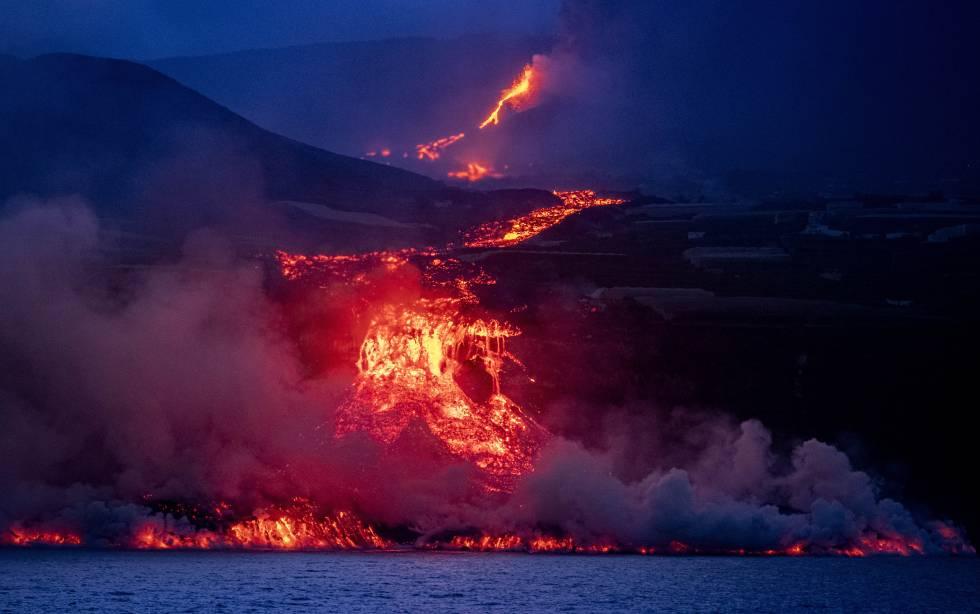By clothing-bag, 07/05/2022
Historical images of the lava from the volcano of La Palma reaching the sea and forming a great cataract of fire on the cliff
María del Mar GonzálezMadrid Updated:Published:
After 10 days of eruption, the lava from the volcano of La Palma has touched the sea and already leaves shocking images of the clash of two great living forces, the land and the sea. The lava, with a temperature of over 1,000 degrees Celsius , has come into contact with the water of the Atlantic Ocean, with a temperature of around 20 degrees. A thermal shock that generates columns (plumes) of water vapor loaded with hydrochloric acid as a consequence of the significant chloride content in seawater.
The first measurements indicate that at the moment there is no toxic cloud , since the values of the atmosphere are normal. The vapor cloud that has formed has changed its direction and is sent by the wind offshore, to the south. The images above are historical, with a large lava waterfall flowing down the cliff and a lava delta jutting out into the ocean.
Many of the curious, neighbors and journalists who have placed themselves in a strategic position to see this moment live have been evicted by the Police, to preserve their health.
A third lava tongue created in the early hours of this Tuesday accelerated the arrival of the magma to the sea. It was created further north of the two existing ones and rode on both of them, thus amplifying the destruction on the island and picking up speed, as if it were sliding on a slide.
Eugenio Fraile, from the Spanish Institute of Oceanography, explained that the lava flow is rushing down the steep cliff and is forming a large mountain in the sea . Furthermore, he specifies that this lava has a more golden color.

A drone from the Geological and Mining Institute has also recorded the moment when the lava touched the sea, leaving the shocking image below these lines.
Consequences of thermal shock
Although the first measurements are positive, experts are especially concerned about what could happen now that the lava has touched the sea and the effects on health. The geologist and scientific communicator Nahúm Méndez has explained that, despite the fact that it is a very "spectacular" phenomenon that can be seen on volcanic islands where the lava that is on the land reaches the sea, it can also generate "explosive phenomena" .
This is because very rapid cooling would occur. As an example, the expert has indicated that the effect would be similar to what happens when we put a very hot glass in a glass of cold water, which causes the glass to break.
In this case, the lava would also break up on contact with a drastically different temperature. "When it breaks up, it can emit all the gases it carries inside , which can generate acids that are toxic to our breathing," Méndez indicated. I was also able to "generate solid particles that can hit us and kill us".
Despite the complexity of the situation, the geologist Nahúm Méndez has sent a reassuring message since Spain has a deployment of the best specialists in the world who are analyzing minute by minute the gases that are emitted, the influence of the wind and the effects on the ocean.
Effects of lava touching the sea |
Precaution and recommendations for the population
Sulfur dioxide can be converted with water into an acid that causes damage to the respiratory tract, discomfort and irritation and even suffocation. In addition, the ash that remains in the environment can irritate the skin, eyes and could also damage our respiratory system.
That is why it is very important not to go near the volcano or the lava flows , nor to meet the lava and the sea, stay at home as long as we can and keep the doors and windows closed. It is important to try not to inhale these gases. And if we had to leave the house, we should cover our nose and mouth, wear glasses to protect our eyes and cover our arms and legs with clothing.
How does it affect marine life?
Juan Tomás Vázquez, a marine geologist, explained a few days ago in Más Vale Tarde what the effect of lava on marine fauna can be. "As it cools, the lava will fracture, releasing gases that will go into the atmosphere and, in part, will remain dissolved in the mass of water, thus producing a loss of the PH of this water," he pointed out.
Due to this loss of pH, numerous species could die. However, the geologist reminds: "They will try to get away from the danger zone, animals are not stupid." The most affected will be the species that live on the bottom, which are not mobile and, therefore, will not be able to flee.
Related Articles